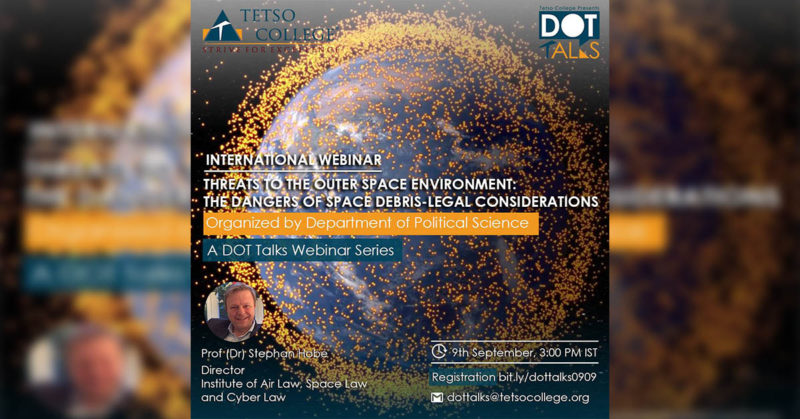To discuss the ‘real’ threat of space debris to the Outer Space Environment and possible mitigation measures from a legal perspective, the Department of Political Science of Tetso College invited Prof. Dr. H.C. Stephan Hobe, Director of the Institute of Air Law, Space Law and Cyber Law as well as Co-Director of the International Investment law Centre Cologne University, Germany in an International Webinar on 9th September, 2020. It was for the first time that a topic related to the International Space Law has been discussed at the academic platform in the state of Nagaland.
While examining the present International Legal Order to see whether there are provisions designed for the protection of outer space and the celestial objects, Dr. Stephan Hobe observed that the ‘Outer Space Treaty’ declares that any State that has registered a space object shall retain legal and de facto jurisdiction and control over that object. As a piece of space debris is considered a ‘space object’ for legal purposes, even if the State were to lose de facto control over the space object when it becomes non-functional or uncontrollable, it retains sole legal jurisdiction and control as per the treaty, he said. However, it is uncertain whether space objects, their component parts or fragments thereof can legally be abandoned or considered abandoned, irrespective of their non-functional status reinforced by the fact that space faring States have hitherto not expressed a right to abandon their non-functional satellites in space, he stated.
The resource speaker observed that this poses serious challenges to the possibility of introducing a legal regime of ‘salvage’ whereby actors other than the State of registry could freely remove pieces of debris accumulated in the usable orbits of the space that pose a threat in Earth orbit and states are not willing to venture into this adventure because of the involvement of heavy cost.
Further, the new legally nonbinding so called ‘Space Debris Mitigation Guidelines’ (Space debris mitigation guidelines of the Inter-Agency Space Debris Coordination Committee) is a soft law instrument containing guidelines with respect to post-mission disposal, however, according to him, the practical implementation of the guidelines has been a matter of concern.
During the Q & A session, there were discussions regarding the role of state actors in cleaning up the space debris. Questions were raised on the measuring aspects of debris and legal responsibility to clean it. One of the participants raised questions about the piled up debris on the Moon as a result of multiple Moon Missions by space agencies ROSCOSMOS and NASA which have pioneered the space exploration programs. The role of Artificial Intelligence and Machine Learning as the means and modes to clean up the Space Debris was also deliberated upon by the participants. One of the participants asked the question as to the possibility of UFOs contributing to the Space Debris.
The talk surmised that the space debris is a serious threat which may have serious repercussions in the near future in the context of an explosion in the aerospace industry, with more and more companies providing commercial launch services and things like satellite-based broadband internet. Participants expressed concern that the current situation in orbit is only likely to get worse. Finally, the speaker and the participants concluded that, with the exception of administrative or legislative solutions, the methods for cleaning up Earth’s orbit are still quite theoretical and will be very expensive to realize but in the interest of the future of humanity, necessary steps, howsoever expensive or impossible they may sound; must be taken at the earliest.

